► Alfa Romeo SZ revisited
► Behind the wheel of a legend
► Underrated or overrated?
If you speak to the locals, there’s a mythical beast that roams Exmoor. A bit more than the average feline: it’s thought to be a cougar or black leopard, released from a private zoo in the 1960s or ’70s after it was ruled unlawful to breed them in captivity outside public zoos.
Despite such cats living at most 15 years, the Beast of Exmoor has been spotted many times over the decades, bringing in inquisitive monster spotters – for which the local tourist board is no doubt thankful.
We’ve brought a beast of our own – ‘Il Mostro’, the monster in Italian, or Alfa Romeo SZ to give the car its proper title. One of the most controversial and divisive cars, let alone Alfas, ever made, it looks like something conjured from Dante’s A-Z of demonic cars. It also sounds like the Beast of Exmoor having a mournful cry. As we dive deep into this dark and mysterious corner of the English countryside, the exuberant blare from its Busso V6 reverberates around the small quaint villages, heralding the SZ’s coming with a plaintive warcry.
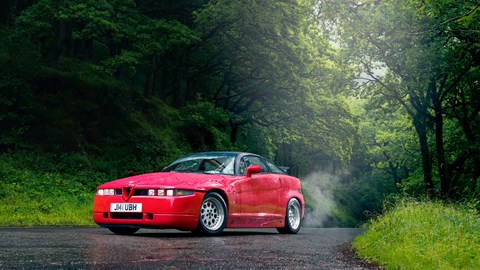
Pedestrians stop and stare, other drivers do double- takes – and even a practising line-dancing troupe pause their machinations to take in this searing red vision of otherness. If ever a car’s looks and sound lived up to its nickname.
But there’s so much more to this car than the way it looks, as we’ll discover. Is it a beast or pussycat?
The Alfa Romeo SZ, driven
You can’t get away from how it looks, though. Whether you like it or not, it holds your attention, which was the plan all along. When Fiat took the Alfa Romeo reins from the Italian government in the mid-1980s, some feared that Alfa’s spirit may be lost via Fiat’s beancounters.
To fight this thinking, Alfa needed a halo car, to capture the imagination after years of underfunding. Alfa’s chief engineer, Stefano Iacoponi, said at the car’s launch: ‘[We] wished to give tangible proof of [Alfa’s] determination to enhance its role as a marque specialising in technically advanced and high-performance cars.’
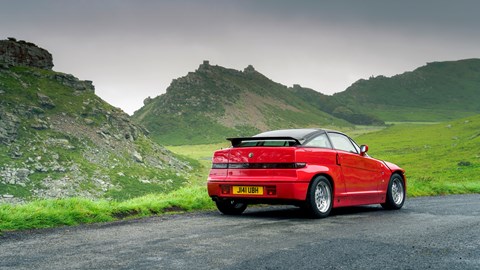
Coming at the dawn of the computer-led design age, the new car – codenamed ES30 – would go from approval to the Geneva Motor Show in just 19 months. The uncharitable may look at the panel gaps and say that wasn’t long enough. Others may look at its stubby shape and wish they hadn’t bothered. Me? I love it. Those panel gaps? Designed to promote more downforce, especially around the front, and to direct airflow around the car. It may look like it has the aerodynamics of a lobbed anvil, but the SZ boasts a slippery 0.30 drag co-efficient.
It’s a riot of materials: the body is composite glassfibre draped over a steel Alfa 75 frame, while carbonfibre pops up on the rear spoiler and interior dials. Initial sketches were penned traditionally, but pioneering use of computer-aided design allowed changes to be tested in polystyrene rather than time-consuming clay. Even so, the final prototype was only finished a month before showtime.
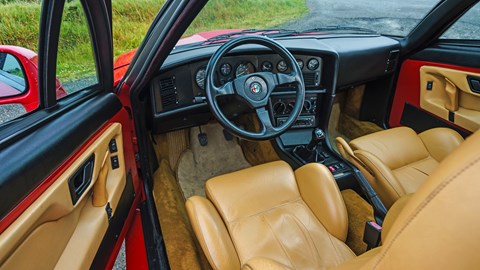
You’ll have already made up your mind on the looks. Since it broke cover in Switzerland, Robert Opron’s unmistakable design has dominated discussions. But there’s so much more to the SZ than the way it looks. From the surprisingly spacious interior, the only thing that’s focusing my attention is the glorious sound rasping out of the back of it. Under the glassfibre bonnet is a 12v version of Giuseppe Busso’s V6, in 3.0-litre single-cam form. The SZ was meant to have the new 24v version that debuted in the 164 and 75, but the project ran out of time.
Each minor toe poke in fifth on the long motorway slog from SZ specialist Alfa Aid’s Maidenhead base has elicited a cat-like meow, largely thanks to the workshop’s brand-new stainless steel exhaust system. Now, the M5 but a brief memory, it’s time to open it up. Suddenly, that cat is shrieking like it’s having its first bath…
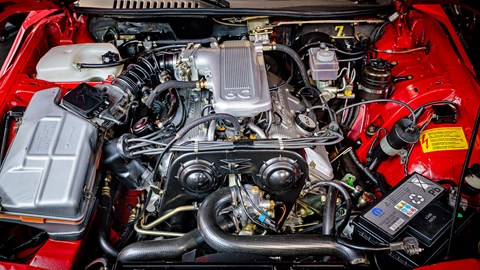
Throttle response is immediate, charging up to 3500rpm with a deep, baritone growl before developing into a howling, mournful blare as it comes on cam and charges for the 6500rpm limit, all operatic harmonics that can’t help but fizz your cochlea, warm the heart and force a grin to your chops. If ever an engine proved those clichés about Italian passion and soul being real, this is it.
It’s not particularly fast in a straight line, though. Its performance figures are about on-par with a Golf GTI Mk5. Could the design and the engine note be flattering to deceive? Is it all bluster, no muster?
Emphatically no. Three decades of bellyaching over its looks have obscured its true talents. It’s far more than its paper numbers and its saloon-derived underpinnings. For its time, it was about as close to the full tarmac rally car experience as you could hope to get in a production car.
That’s because underneath that concept car exterior is… well, a tarmac rally car. Alfa Romeo’s efforts with the 75 in Group A touring car racing had been a bit of a dud. The Turbo Evoluzione was outgunned in the turbo class by the Ford Sierra RS500 by a deficit of about 100bhp, and out-nimbled by the naturally aspirated M3 (E30).
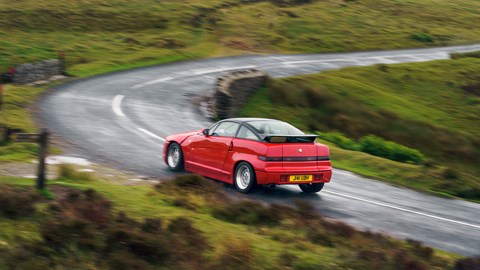
About halfway through the 1987 World Touring Car Championship, Alfa bowed out to focus on other projects. The most famous of these were the Brabham F1 effort and the associated 164 Procar, but the most practical programme was the Giro D’Italia. This round-Italy event took in stage rallies and circuit events, and allowed cars run to IMSA rules. Shorn of its Group A restrictions, the 75 Turbo Evolution’s wick was turned up to 400bhp.
More importantly, the race car chassis was to form the underpinnings of the SZ, and with names such as Patrese, Biasion, Nannini and Larini acting as chassis test engineers, the best men were on the job, all under the watchful eye of Fiat/Abarth/Lancia/Alfa Corse motorsport supremo Giorgio Pianta.
Working with Zagato, who would build the car rather than design it, Pianta developed a car that though clearly related to the 75, was very different. The standard 75 suspension was junked for an independent system with transverse wishbones at the front, and a rigid de Dion rear axle with converging rods and a Watts linkage. Hydraulic telescopic dampers, anti-roll bars and uniball joints were put in place fore and aft. There’s a limited-slip diff with a 25 per cent lock out back, and the ride height is adjustable via the cabin. All space age for the late ’80s – and a feeling of hyperspeed is what happens in the bends.

Forget the acceleration stats and horsepower figures. Instead, this is about searing cross-country pace. Keep the engine on cam and the car simply keys in. Sharp steering is a hallmark of any good Alfa, but most have a little lightness around the dead-ahead before firming up as you get more adventurous with physics. The SZ is different – it’s still super-sharp (3.2 turns lock to lock) but that lightness is gone. Instead, you’ve got intuitively accurate, responsive steering, and a weighting that’s as perfect as an expensive Swiss timepiece. It feels… well, just right.
Then there’s the suspension compliance. Sharp shocks rattle through the cabin. Because all SZs are left-hand drive, your coccyx will soon recognise individual brands of drain covers from vibrations alone. More important, however, is the way the SZ works the cambers and undulations in the road, absorbing them rather than skittering off them. You can push harder and faster, your inputs seemingly acting on the SZ’s blunt nose as if by telepathy, while the rear rarely feels overwhelmed.
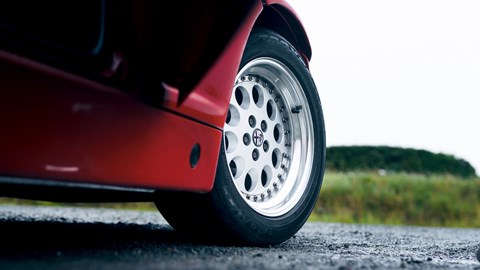
In the dry, the SZ is unstickable; there’s so much grip you can happily pull 1.5g in the corners. Remember – this is a car released in 1989. Soon you’re threading together corners in single-minded fashion. You even forget you’re sat on the ‘wrong’ side of the car. It’s less forgiving in the wet – its very short wheelbase gives you a tiny window of opportunity to save it if your luck runs out.
You can tell the competition breeding, though the plush interior may convince you otherwise. The cabin was meant to be much more spartan, but that wouldn’t do for the company’s flagship that touched Porsche 928 S4 money. The dashboard wraps around you, the dials glowing green in the dark. There are also beautiful tan leather chairs, a Momo steering wheel and acres of space. I even had to move the seat forward a bit – a novelty, that.
On smooth A-roads it’s comfortable – well, aside from the occasional grate or pothole trying to reorganise your spinal column – but there’s no getting away from that engine, either through the glorious yelps as you give in to temptation and charge to 6500rpm again, nor the heat wanting to join you in the cabin.
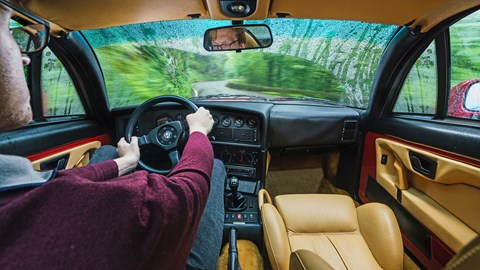
The gearchange may cause you to sweat. The box is at the back, contributing to a well-balanced 56/44 front-rear weight split, but it’s a cable change. First to second takes a degree of faith, and reverse is a trip into a fantasy land where the correct ratio appears with all the certainty of a passing deity. This isn’t a change that likes to be rushed. Shame, because the rest of the car’s abilities, and the manic energy it encourages, are almost stymied. Almost…
Instead, you learn to live within its five, fairly widely spaced ratios. The throttle response is so quick, and its feelsome grip level (in the dry) means that you can keep it on cam for longer, riding the torque, scanning the horizons and reeling off corners like Miki Biaision in his pomp. There are class-A narcotics less addictive than this.
You may think the car is ugly, and be unable to forgive it that. But the way this monster handles is truly beautiful.
This article originally appeared in the 2020 September issue of Modern Classics.

The Alfa Romeo SZ is a deliciously contradictory car. On the one hand, it’s far more relevant and less visually jarring than it was when it first broke cover as the ES30 ‘Il Mostro’ in 1991. In today’s world packed with me-too SUVs and Chinese EVs, its once-challenging design looks like a model of effortless restraint that’s somehow quite timeless. Its entertaining dynamics and punchy performance also make it very useable – and a car that I’d happily drive every day. Who really needs the 600bhp-plus that modern supercars routinely boast?
But with values now broaching £80,000 this usable testament to Robert Opron’s design genius is probably too precious to risk being anything other than a light-use weekend toy. It’s a curse that top-drawer classics face, of course, but it’s a real shame that such a glorious car is unlikely to be driven hard and often by its doting owners. I’d love the chance to try.